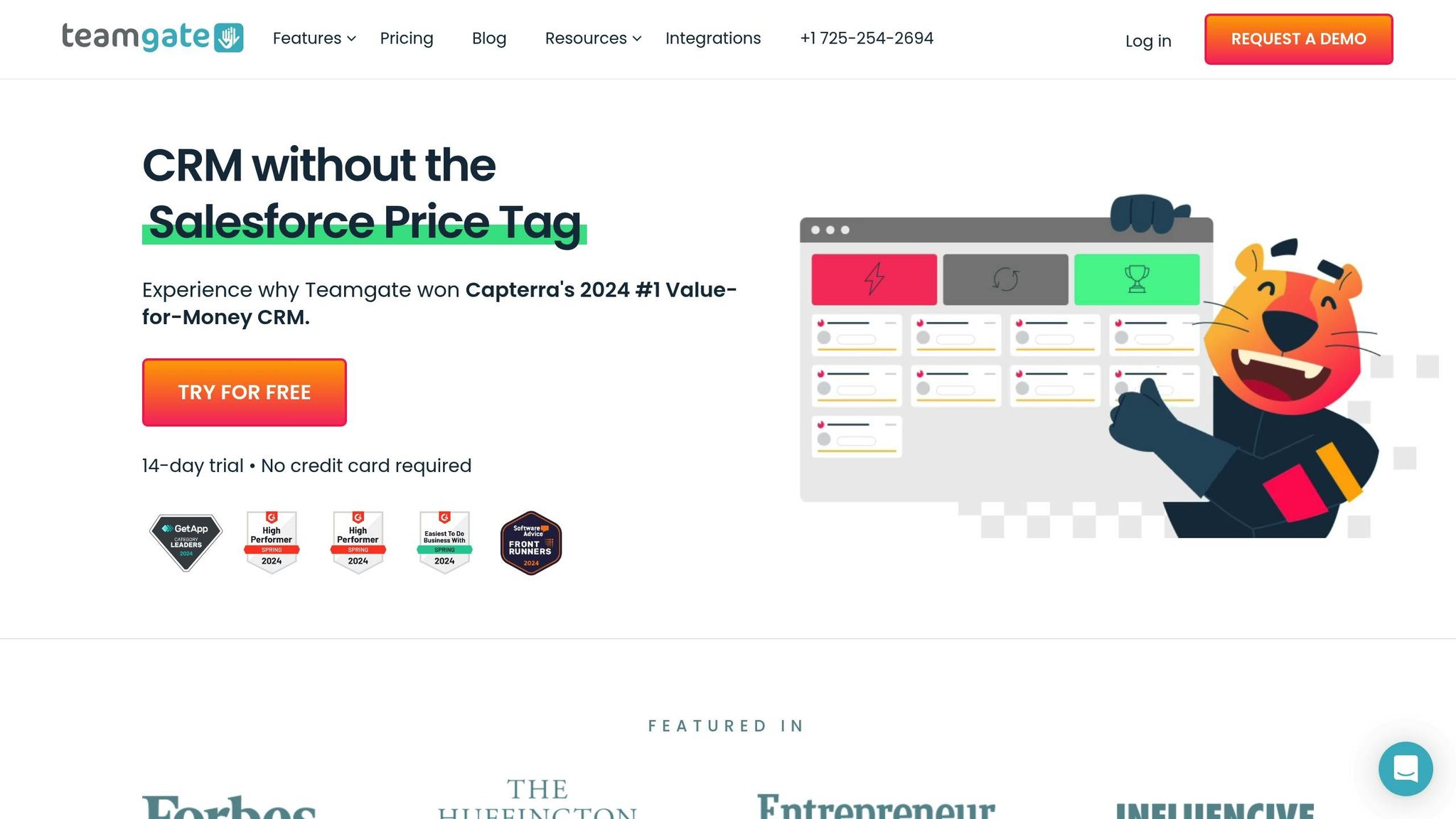Sales teams often struggle with vague objectives like "increase revenue." S.M.A.R.T. goals – Specific, Measurable, Achievable, Relevant, and Time-bound – provide clarity and direction, turning broad targets into actionable steps. This approach improves focus, accountability, and measurable progress, especially when integrated with CRM tools.
Key Takeaways:
- Specific Goals: Define clear targets (e.g., "Increase customer satisfaction from 7.2 to 8.5").
- Measurable Progress: Use metrics like KPIs to track success (e.g., lead conversion rates).
- Achievable Objectives: Set realistic goals based on CRM data and team capacity.
- Relevant Alignment: Ensure goals match business priorities (e.g., targeting new markets).
- Time-Bound Deadlines: Add urgency with clear timelines (e.g., "by December 31st").
CRMs like Teamgate enhance S.M.A.R.T. goals by offering tools for tracking, automation, and analytics. For instance, dashboards provide real-time metrics, while automated workflows streamline tasks. These features help identify gaps, improve team performance, and ensure goals are met effectively. By using S.M.A.R.T. goals within CRMs, teams can achieve better results and align their efforts with business growth.
Why it’s important to set goals in your CRM
Understanding Each S.M.A.R.T. Goal Component for Sales and CRM
Breaking down the S.M.A.R.T. framework helps sales teams turn vague ideas into specific, actionable goals that drive measurable results. Each component plays a role in creating a clear roadmap for success. Let’s dive into how these elements can elevate your sales and CRM strategies.
Specific: Setting Clear Sales Targets
The "Specific" part of S.M.A.R.T. is all about clarity. Instead of a vague goal like "improve customer relationships", a specific goal might be: "Increase customer satisfaction scores from 7.2 to 8.5 by implementing personalized follow-up sequences for enterprise clients."
By defining objectives clearly, you can align your CRM and sales strategies with broader business goals. This not only enhances customer satisfaction but also streamlines your processes.
Here are some examples of specific goals:
- Reduce lead response time from 4 hours to 30 minutes for inbound inquiries
- Increase conversion rates for demo requests from 23% to 35% within the next quarter
- Grow monthly recurring revenue from enterprise accounts by $50,000 by December 31st
Specific goals often stem from identifying customer needs and personalizing interactions. For instance, if CRM data shows prospects drop off after demos, you could set a goal to improve demo-to-proposal conversion rates by 15%. Mapping the customer journey and focusing on key touchpoints ensures your goals are both targeted and impactful.
Measurable: Tracking Key Performance Indicators (KPIs)
Measurable goals give you concrete numbers to track progress. Think of Sales KPIs as the metrics that connect your team’s performance to overall business success.
For example, data-driven sales teams tend to outperform others, achieving 5–6% higher productivity. Unlike generic metrics, KPIs are designed to directly reflect business priorities.
Here’s a quick comparison of two companies’ approaches to measurement:
- Joy’s Toys aimed for growth but didn’t set clear KPIs for lead generation, which led to inconsistent revenue.
- Saul’s Dolls, on the other hand, defined KPIs for lead generation, quota attainment, and customer retention. This clear focus helped them hit or surpass revenue targets.
Tracking the right KPIs consistently can yield impressive results. For instance, businesses using CRM systems report increased revenue by as much as 41% per salesperson. The key is choosing metrics that directly align with your goals.
Achievable: Setting Realistic Yet Motivating Goals
Goals should challenge your team without being unrealistic. Aiming too high can demotivate, while goals that are too easy won’t push your team to grow. The balance lies in using your CRM’s historical data to set benchmarks that are ambitious but achievable.
For example, if your team’s average deal size is $15,000, jumping to $50,000 in a month is unrealistic. However, increasing it by 20% to $18,000 over three months strikes a better balance.
When setting achievable goals, consider these factors:
- Historical performance data from your CRM
- Current market conditions
- Team capacity and available resources
- Training and development needs
Investing in employee training and resources is crucial for success. For example, effective CRM use has been shown to boost retention rates by 27%. Once goals are realistic, ensuring they align with your company’s priorities becomes the next step.
Relevant: Aligning Goals with Business Objectives
Relevant goals ensure individual efforts contribute to the company’s broader vision. Whether your focus is on increasing revenue, entering a new market, or improving customer retention, aligning goals with these priorities ensures everyone works toward the same outcomes.
For instance, if your company is expanding into the healthcare sector, relevant CRM goals might include:
- Building a healthcare-specific lead scoring model
- Creating tailored email sequences for healthcare prospects
- Developing compliance-focused reporting dashboards
This alignment is essential because 76% of consumers feel frustrated when businesses recommend irrelevant products or services. Regularly reviewing your strategy ensures your goals stay aligned with evolving market demands.
Time-Bound: Setting Deadlines for Success
Time-bound goals add urgency and structure, making it easier to track progress. Clear deadlines also foster collaboration, as everyone knows what they’re working toward.
For instance, instead of saying, "increase lead generation this year", a time-bound goal would be: "Generate 150 qualified leads per month by March 31st, with weekly progress reviews every Friday."
Your CRM can play a key role here by automating reminders, tracking progress, and sending alerts to keep deadlines on track. In fact, businesses using CRM systems are 86% more likely to exceed their sales targets.
"A goal properly set is halfway reached." – Zig Ziglar
Using Teamgate CRM to Support S.M.A.R.T. Goals

Teamgate CRM integrates seamlessly with S.M.A.R.T. goals by aligning its features with each component – specific targets, measurable outcomes, achievable plans, relevant actions, and deadlines. It transforms vague objectives into actionable and trackable outcomes, ensuring every element of S.M.A.R.T. goals is addressed.
Using Dashboards and Analytics for Goal Tracking
Teamgate’s dashboards act as a central hub, offering a clear visual representation of key sales metrics. This real-time visibility is critical, especially since only 50% of sales teams currently rely on data for accurate forecasting and decision-making.
The platform goes beyond basic reporting. You can dive into team performance, analyze deals won or lost, track lead sources, and assess marketing campaign success. It provides real-time metrics like new leads, pipeline value, and forecast projections, enabling teams to monitor daily progress effectively.
With Teamgate Insights, all essential sales metrics are centralized. This feature allows users to compare data across different timeframes, making it easier to assess progress toward time-bound goals. Sales managers can set and evaluate targets for team activities, while individual team members can track their performance to stay motivated and productive.
The results speak for themselves. In 2024, Baremetrics achieved a 132% increase in conversion rates by leveraging Teamgate’s advanced analytics. Allison Barkley, Director of Operations at Baremetrics, highlighted how Teamgate is specifically tailored for SaaS teams. Packagecloud also saw an 18% boost in engagement rates by refining scripts and targeting leads based on insights from Teamgate.
Teamgate’s risk management tools further support goal-setting by identifying highs and lows in live opportunities. This real-time feedback allows for immediate action, helping teams avoid potential obstacles. Features like win ratio tracking also guide teams in refining their strategies to close deals more effectively, directly impacting specific conversion goals. Combined with automation, these insights streamline the path to achieving objectives.
Automating Workflows and Reminders
Teamgate’s automation tools complement its analytics by ensuring consistent progress toward goals. Automated reminders and workflows send instant notifications for new leads, helping teams stay on schedule.
But the automation doesn’t stop there. Teamgate can assign leads based on predefined criteria, send follow-up emails at optimal times, and update deal stages as prospects move through the pipeline. This structured approach reduces human error and ensures that goals remain achievable. Workflows can also be tailored to prioritize business needs – such as triggering unique actions for high-value enterprise clients versus smaller prospects.
Customizing Fields and Pipelines for Specific Goals
Customization is another way Teamgate supports S.M.A.R.T. goals. Custom fields allow users to manage deal information and record details directly tied to their objectives.
The platform also enables the creation of multiple sales pipelines, each with its own reporting, tagging, and search functions. This is particularly useful for targeting different market segments with distinct goals. Separate pipelines let teams track progress for each segment independently while maintaining overall visibility.
Managing sales pipelines with Teamgate is straightforward. The drag-and-drop interface makes it easy to move deals through various stages, providing a clear visual of potential bottlenecks. Indicators for estimated closing dates ensure teams can quickly identify which opportunities need immediate attention to meet deadlines.
The customization extends to analytics and reporting. Users can create custom fields to capture data points most relevant to their goals. This ensures that the CRM does more than just store data – it actively supports the process of achieving objectives. With these tools, implementing and monitoring S.M.A.R.T. goals becomes an organized and efficient process.
sbb-itb-5772723
How to Implement and Monitor S.M.A.R.T. Goals with Teamgate CRM
Teamgate CRM makes it easier to apply the S.M.A.R.T. framework by turning vague objectives into clear, measurable targets that boost performance. Here’s how you can set and track your goals effectively using the platform.
Step-by-Step Implementation Process
Start by accessing the goal management system through the Insights section and navigating to Goal settings. Teamgate offers a variety of goal types, such as Sales Revenue, Completed Calls, and Sent Emails, all of which align with the S.M.A.R.T. criteria. You can set goals for different timeframes – monthly, weekly, or daily – and the system will automatically break down monthly targets into shorter-term objectives.
Assigning goals is straightforward. Select "Add users into the table", choose the team members, and click "set" to assign targets. You can input values manually or use drag-and-drop for convenience. Need to make changes? Simply select the cells and press delete to adjust. You can also modify time periods using the built-in calendar or arrow navigation tools. Keep in mind that the system requires goals to be set before it can calculate statistics in the Dashboard and Insights sections. This ensures that tracking begins only after clear, measurable objectives are in place.
Once your goals are set, the next step is to monitor them regularly to ensure they align with daily activities and overall business objectives.
Best Practices for Regular Monitoring
With your goals established, Teamgate’s dashboard becomes a powerful tool for tracking progress. The "Activity goals vs. Performance this month" section provides a quick overview of how you’re doing, while the Insights section allows for a more detailed analysis of trends over various timeframes.
Schedule weekly check-ins to review progress and address any challenges. These sessions should cover team performance, deals won or lost, lead sources, and the outcomes of marketing campaigns. Pay close attention to the dashboard’s risk management features, which highlight changes in live opportunities. Monitoring metrics like win ratios can help pinpoint the steps needed to close deals successfully.
Pipeline management tools within Teamgate are especially useful for spotting bottlenecks early. Identifying and resolving these obstacles promptly can prevent them from derailing your overall progress. To gain a clearer picture of your performance, download data regularly. This helps differentiate between short-term fluctuations and long-term trends, offering valuable insights for strategy adjustments.
Both sales managers and team members can use these tools to stay on top of their KPIs. By fostering a culture of accountability, you ensure that daily actions remain aligned with your broader business goals. Regular engagement with these reporting features transforms insights into actionable strategies, keeping your team on track to achieve their targets.
Common Challenges in S.M.A.R.T. Goal Setting and Solutions
Sales teams often face hurdles when working with S.M.A.R.T. goals, which can throw progress off track. Setting clear and actionable goals is essential for sales success, and tackling common issues head-on ensures your strategy stays aligned with S.M.A.R.T. principles. By recognizing these challenges – and leveraging your CRM effectively – you can pave the way for better results.
Common Challenges and How to Fix Them
One major issue is unclear metrics. When key performance indicators (KPIs) aren’t well-defined, it becomes nearly impossible to gauge progress. For instance, a team may aim to "increase revenue", but without specific metrics like revenue targets, conversion rates, or call volumes, efforts can feel directionless. To fix this, establish precise KPIs that tie directly to your business goals. For example, instead of a vague objective, set a target like increasing monthly recurring revenue by a certain percentage or improving the conversion rate on qualified leads.
Another challenge is insufficient CRM usage. Research indicates that 38% of salespeople believe their company needs to improve how it measures and rewards CRM engagement. When team members resist using the system or only partially engage, goal tracking becomes fragmented and unreliable. Address this by offering robust training programs that focus on quick wins and demonstrate the immediate benefits of CRM adoption.
Finally, unrealistic targets can demoralize teams and lead to abandoned goals. Unrealistic expectations often stem from poor performance assessments. Use historical data to set targets that are challenging yet achievable, ensuring that your team remains motivated and focused.
| Challenge | Cause | Fix |
|---|---|---|
| Unclear metrics | Vague goal definitions | Define specific KPIs aligned with business objectives |
| Insufficient CRM usage | Resistance or lack of training | Provide training and emphasize quick wins |
| Unrealistic targets | Poor performance assessment | Set achievable goals using historical data and review regularly |
Teamgate CRM is designed to tackle these issues head-on with tools that streamline tracking and automation.
Improving Goal Processes with Teamgate
Teamgate CRM offers a suite of tools that simplify goal-setting and tracking, helping you overcome common obstacles. The platform’s Insights section acts as a central hub for monitoring sales performance. This feature provides real-time visibility into key metrics, eliminating the ambiguity that often arises from unclear measurements.
The system supports a wide range of goal types, including sales revenue, completed calls, successful calls, sent emails, planned meetings, and completed meetings. This flexibility allows you to create specific, measurable objectives tailored to your team’s responsibilities.
Tracking progress is straightforward with Teamgate’s dual monitoring system. The dashboard’s "Activity goals vs. Performance this month" feature offers a quick overview of current performance, while the Insights section provides deeper analytical tools. You can compare metrics across time periods and download detailed reports for in-depth performance reviews.
Teamgate’s goal-setting tools are designed to keep your team focused and on track. By setting clear, measurable objectives upfront, the platform ensures performance statistics are meaningful and actionable. Additionally, businesses that invest in CRM systems like Teamgate often see an impressive $8.71 return for every dollar spent. To get the most out of the system, use its comparison features to benchmark current performance against historical data. This helps you set realistic targets and avoid the pitfalls of unattainable goals.
Conclusion: Achieving Sales Success with S.M.A.R.T. Goals
Pairing the S.M.A.R.T. methodology with Teamgate CRM turns sales goals into clear, actionable steps that drive customer success and revenue growth.
Here’s what the data tells us: only half of sales teams rely on data for accurate forecasting, but those that do see impressive results. For every $1 invested in a sales CRM, the average return exceeds $8. Companies that can forecast sales within a ±5% accuracy range gain the confidence to plan strategically for the future. Yet, only 21% of sales teams manage to forecast within a 10% margin. These insights highlight the importance of using data-driven tools to bridge the gap between guesswork and precision.
Success stories illustrate how this approach works in practice. For example, Packagecloud increased engagement rates by 18% through targeted experiments, while Baremetrics achieved a 132% boost in conversion rates by leveraging insights from Teamgate CRM. These examples prove that aligning sales strategies with S.M.A.R.T. goals leads to tangible improvements.
The transformation happens when teams move from hoping for results to systematically achieving them. Teamgate CRM makes this shift possible by offering robust tracking tools – everything from monitoring sales trajectories and profitability to analyzing lost deals and identifying top customers. Real-time activity metrics show which actions drive success, while goal-setting features ensure the team stays focused on priorities.
Creating a sustainable sales culture means every team member knows their role in achieving the bigger picture. When sales teams adopt this structured approach, they align their efforts, stay motivated, and consistently hit goals that once felt out of reach. With clear objectives, measurable progress, and the right technology, teams can build a foundation for long-term success, where every individual contributes to a shared vision.
FAQs
How does using S.M.A.R.T. goals with Teamgate CRM boost sales performance?
Integrating S.M.A.R.T. goals with Teamgate CRM can elevate your sales efforts by setting clear, actionable objectives that align perfectly with your strategies. This method ensures your team concentrates on specific and measurable outcomes, making it simpler to track progress and maintain accountability.
Teamgate allows you to keep an eye on key metrics, simplify workflows, and focus on tasks that directly contribute to achieving your sales targets. By syncing your CRM tools with well-defined goals, you cultivate a more structured and efficient sales process, driving stronger results and building better customer relationships.
What are some clear examples of S.M.A.R.T. goals for a sales team using CRM data?
Here are a few examples of S.M.A.R.T. goals designed for a sales team using CRM data effectively:
- Bring in 600 new customers by March 31, 2024, by focusing on industries or regions highlighted in the CRM.
- Boost sales revenue by 15% in Q4 over Q3 by refining follow-up processes tracked in the CRM.
- Cut customer churn by 4% by the end of Q1 through personalized outreach campaigns guided by CRM analytics.
- Add 12 qualified leads daily to the CRM by targeting high-potential prospects.
These goals are clear, measurable, and directly linked to actionable insights from CRM data, making it easier to monitor progress and achieve meaningful results for your sales team.
What challenges do sales teams face when setting S.M.A.R.T. goals, and how can CRM tools help solve them?
Sales teams often face challenges like setting practical and achievable goals, establishing measurable objectives, and maintaining focus to hit their targets. Without clarity, priorities can become scattered, leading to missed opportunities and confusion.
This is where CRM tools, such as Teamgate CRM, come into play. They make the goal-setting process much easier by offering real-time tracking and insights into sales performance. These tools help align team efforts with S.M.A.R.T. criteria, ensuring goals are not only clear but also attainable and relevant. The result? A more motivated team, improved accountability, and better overall outcomes.





